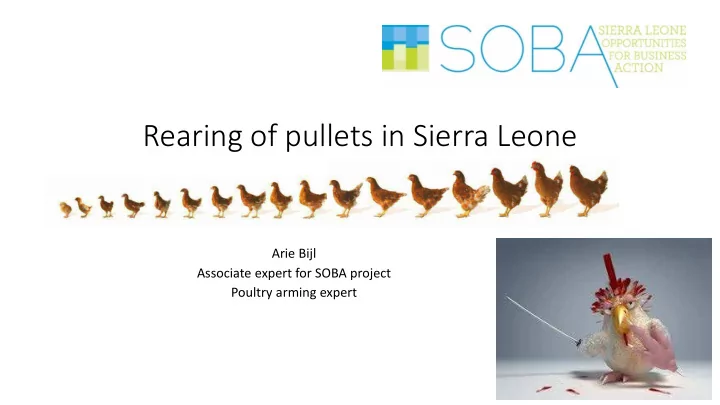

Rearing of pullets in Sierra Leone Arie Bijl Associate expert for SOBA project Poultry arming expert
Rearing period is most important • Building the body • Building immunity • Do not compromise on feed composition: follow breeders or concentrate manufacturer recommendations
Rearing management 1) preparing the house for chickens 2) Hygiene and biosecurity 2) receiving the chicks 3) house climate 4) bodyweight 5) light 5) feed 6) beak trimming 7) administration
Preparation of house Cleaning • water • dry Disinfection • clean surfaces • right disinfectant • right temperature (period) • right RH
Hygiene and biosecurity • Fence around farm • No backyard fowl near the houses • No entry of wild bird into the houses • Vermin control • Hygiene lock for entering the poultry house • Disinfect equipment A Entrance / exit • Workers and visitors disinfect at entrance B Exit to clean area • Visitors only when necessary C Storage cupboard D Hand basin • ………………… E Boot rinse F Laundry basket
Receiving day old chicks Start heating in time Floor rearing -> floor temperature 26 o C Free of odours of disinfection Temperature 36 o C Thermometer Relative Humidity above 60 % Hygrometer
Climate control • Temperature • Relative Humidity • Minimum ventilation • Air composition • Air movement
Alternative brooding US $ 70 each Fuel: butane or propane gas
Minimum ventilation Calculated • 15-20 % of maximum ventilation=3.6 m 3 / kilogram bodyweight/ hour • => 0.6-0.7 m 3 / kilogram per hour • + correction for fuel when direct heating Measured • gasses at a low level CO2; • maintain temperature
Air velocity Small chicks 0.1 m/s Later (normal temperature) 0.25 m/s
Light Normal program as management guide Gradually decrease light to only daylight at 15 weeks When 1 st egg: increase 2 hours At 35 % lay: 2 hours more At 60 % lay: 2 hours more (total 18 hours) (source ISA Brown management guide) Normal fluorescent tubes not suitable because of interaction with sight of chickens.
Feed Feeder space correct. (round feeders 1 per 30 birds; 10 centimetres per bird; laying period) Feed on paper on floor first days Water • number or space sufficient • water quality/ hygiene
Beak trimming Shortening beaks to prevent damage of feather and damage by cannibalism. Age: • At the hatchery (laser technique) • before 10 days • 6 weeks Type • trimming • burning Do it well or don’t do it !!!!
Perches • Exercise • Natural behaviour • Cooling
Body weight Average bodyweight Uniformity Why monitoring bodyweight Feed management Managing start of production
Administration Standard system • room temperatures • mortality • feed consumption • bodyweight development
Recommend
More recommend